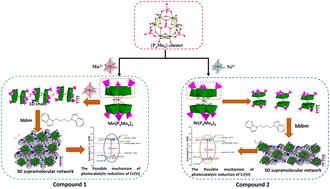Two reduced phosphomolybdate-based metal–organic complexes modified by tunable bis-1H-benzimidazole ligands for enhanced photocatalytic Cr(VI) reduction
IF 3.3
3区 化学
Q2 CHEMISTRY, INORGANIC & NUCLEAR
引用次数: 0
Abstract
The strategic development of polyoxometalate-based complexes for enhanced photocatalytic Cr(VI) reduction in wastewater remains a significant challenge in environmental remediation. In this work, two flexible bis-1H-benzimidazole ligand-functionalized reduced phosphomolybdate-based complexes with the formulas (H2bbbm)3[Mn(H2O)2]{Mn[P4MoV6O31H7]2}·8H2O (1) and (H2bbbm)3{Ni[P4MoV6O31H8]2}·6H2O (2) (bbbm = 1,1′-(1,4-butanediyl)bis-1H-benzimidazole) were hydrothermally prepared and comprehensively characterized by multiple analytical techniques. Single-crystal analysis reveals that compound 1 exhibits a 3D network structure constructed through hierarchical assembly: Mn2+-bridged {Mn[P4Mo6O31H7]2}8− dimers first form 1D inorganic chains, which are then interconnected by protonated [H2bbbm]2+ ions via supramolecular interactions to generate the final 3D architecture. However, compound 2 is revealed as a 3D supramolecular network, which is formed by classical 0D {Ni[P4MoV6O31H8]2}6− dimeric clusters and protonated [H2bbbm]2+ ions. When employed as visible-light photocatalysts, compounds 1 and 2 manifested excellent photocatalytic performance in Cr(VI) reduction with removal rates of 99.25% for 1 and 98.09% for compound 2 after only 8 minutes, respectively. In addition, the reduction process followed pseudo-first-order kinetics with respect to Cr(VI) concentration, exhibiting outstanding k values of 0.623 min−1 for compound 1 and 0.511 min−1 for compound 2, respectively. Notably, compound 1 demonstrates superior photocatalytic performance. Meanwhile, both compounds still displayed excellent capability for Cr(VI) reduction in real water samples, underscoring their significant potential for practical application. Mechanistic studies demonstrate that the M{P4Mo6}2 clusters play a critical role in photocatalytic performance. The synergistic effect among polyoxometalate anions, bridging metal centers (M), and the flexible bis(1H-benzimidazole) ligand enhances photocatalytic activity by modulating the band gap of the photocatalysts. This study establishes a design strategy for high-performance visible-light photocatalysts by adjusting the structural composition of reduced phosphomolybdate systems, offering new solutions for environmental pollutant treatment.

两种可调双- 1h -苯并咪唑配体修饰的磷钼酸盐基金属有机配合物用于增强光催化Cr(VI)还原
多金属氧酸盐基配合物的战略发展,以增强光催化废水中Cr(VI)的还原仍然是环境修复中的一个重大挑战。本文采用水热法制备了两种柔性双1h -苯并咪唑配体功能化的还原性磷钼酸盐配合物,分子式为(H2bbbm)3[Mn(H2O)2]{Mn[P4MoV6O31H7]2}·8H2O(1)和(H2bbbm)3{Ni[P4MoV6O31H8]2}·6H2O (2) (bbbm = 1,1′-(1,4-丁二基)双1h -苯并咪唑),并用多种分析技术对其进行了综合表征。单晶分析表明,化合物1表现出通过分层组装构建的三维网络结构:Mn2+桥接的{Mn[P4Mo6O31H7]2}8−二聚体首先形成一维无机链,然后通过质子化[H2bbbm]2+离子通过超分子相互作用相互连接,形成最终的三维结构。然而,化合物2是由经典的0D {Ni[P4MoV6O31H8]2}6−二聚体簇和质子化的[H2bbbm]2+离子形成的三维超分子网络。作为可见光光催化剂,化合物1和2表现出优异的光催化Cr(VI)还原性能,仅8分钟后,化合物1的去除率为99.25%,化合物2的去除率为98.09%。此外,化合物1的k值为0.623 min−1,化合物2的k值为0.511 min−1,与Cr(VI)浓度相关的还原过程符合准一级动力学。值得注意的是,化合物1表现出优异的光催化性能。同时,这两种化合物在实际水样中仍表现出优异的Cr(VI)还原能力,具有重要的实际应用潜力。机理研究表明,M{P4Mo6}2簇在光催化性能中起关键作用。多金属氧酸阴离子、桥接金属中心(M)和柔性双(1h -苯并咪唑)配体之间的协同作用通过调节光催化剂的带隙来增强光催化活性。本研究通过调整还原性磷钼酸盐体系的结构组成,建立了高性能可见光光催化剂的设计策略,为环境污染物处理提供了新的解决方案。
本文章由计算机程序翻译,如有差异,请以英文原文为准。
求助全文
约1分钟内获得全文
求助全文
来源期刊

Dalton Transactions
化学-无机化学与核化学
CiteScore
6.60
自引率
7.50%
发文量
1832
审稿时长
1.5 months
期刊介绍:
Dalton Transactions is a journal for all areas of inorganic chemistry, which encompasses the organometallic, bioinorganic and materials chemistry of the elements, with applications including synthesis, catalysis, energy conversion/storage, electrical devices and medicine. Dalton Transactions welcomes high-quality, original submissions in all of these areas and more, where the advancement of knowledge in inorganic chemistry is significant.
 求助内容:
求助内容: 应助结果提醒方式:
应助结果提醒方式:


